GPS running watches offer a significant upgrade over traditional fitness trackers. In addition to tracking step counts and measuring distances, GPS watches provide a comprehensive array of advanced training metrics.
Since 2014, we’ve rigorously tested 37 different watches, conducting hundreds of heart-rate readings and wearing them during both long and short runs on trails and tracks, as well as in races.
Our findings reveal that the dependable Coros Pace 3 stands out as the best option for most runners, thanks to its swift GPS acquisition and exceptional battery life.
Our testing has shown that the reliable Coros Pace 3—with its speedy GPS acquisition and outstanding battery life—is the best choice for most runners.
For those seeking more smartwatch-like features beyond what the Pace 3 offers, the Garmin Forerunner 165 and Garmin Forerunner 165 Music provide the best overall value in Garmin’s lineup. Additionally, the Forerunner 45 serves as a solid, streamlined option for beginners looking to start their running journey.
Who this is for
By finding and mapping new routes, a GPS running watch can help you diversify workouts.
For runners interested in long races, a GPS watch should accurately mark your pace and distance to help you improve over time.
Although the focus of this review is tracking runs, most GPS watches also offer tracking for swimming and cycling.
If you want to upgrade from a fitness tracker, a GPS running watch may provide more detail about your daily activities.
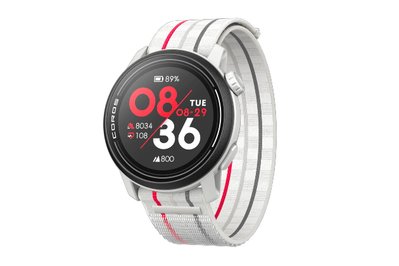
Coros Pace 3
The best GPS running watch
This watch excels at tracking runs. It has a better GPS and battery life than the competition, but its touchscreen display is not as sharp.
Coros Pace watches have been lauded for their long-lasting batteries, quick GPS acquisition times, and accurate tracking capabilities. The Coros Pace 3 further improves on those attributes, and it adds some long-desired features, like dual-frequency GPS tracking and music storage—all without a steep price hike.
Compared with previous watches in the series, the Pace 3 offers a better GPS—arguably its most notable upgrade. Due to the dual-frequency GPS tracking, this watch can connect to up to five satellites, theoretically creating better signals in remote areas or when the user is surrounded by tall buildings (the Pace 2 connected to two only satellites).
In our test runs, surrounded by signal-scattering skyscrapers in New York City, the Pace 3 had the quickest GPS signal-acquisition time of our picks.
The Pace 3 also has the longest battery life of our picks. It has a color touchscreen, but it lacks AMOLED, which creates the vibrant colors you see on many smartphones and higher-end running watches, including our runner-up pick.
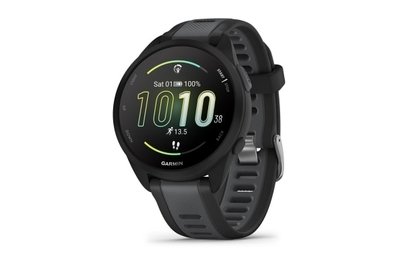
Garmin Forerunner 165
A GPS running watch with a smartwatch feel
This watch has an AMOLED touchscreen and advanced run-tracking features. But it has a shorter battery life than our top pick, and it often takes longer to acquire a signal.
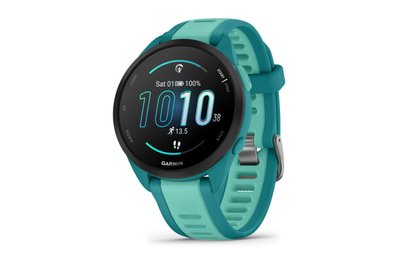
Garmin Forerunner 165 Music
The same watch, plus music
This is the same watch, but with music-streaming and storage capabilities.
The Garmin Forerunner 165 is a welcome addition to the very popular GPS running-watch series. New to this model: an AMOLED touchscreen for $200 less than the Forerunner 265s (previously the least-expensive Forerunner model with an AMOLED display).
The Forerunner 165 lacks some of the more-intensive training features of the 265s (like training-readiness scores), but it still offers plenty of valuable running metrics, like running power readings and cadence feedback. The watch gathers a GPS signal fairly quickly, but not as quickly as the Coros Pace 3.
If you want extensive music storage and streaming capabilities, Garmin offers the Forerunner 165 Music version (for an additional $50).
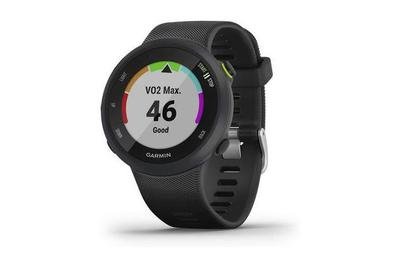
Garmin Forerunner 45
A solid running watch that covers the basics
This pared-down watch has fewer features than our other picks (and no touchscreen), but it still tracks runs better than most fitness trackers.
If you’re new to tracking runs with a GPS watch, and you are willing to compromise a bit on signal-acquisition speed and don’t want or need a touchscreen, consider the Garmin Forerunner 45.
It doesn’t have as many activity modes as other Forerunner models, but it has reliable GPS. And it performs almost as well as our top pick and runner-up pick at accurately measuring distance.
I found that the heart-rate monitor showed bigger discrepancies during intense workouts (I tested all of our watches with a trusted heart-rate-monitor chest strap). And it lacks swim tracking, music storage, and the AMOLED screen found on pricier Forerunner models (including the 165).
The research
How our picks compare
Why you should trust us
Who this is for
How we picked and tested
Our pick: Coros Pace 3
Runner-up: Garmin Forerunner 165
Budget pick: Garmin Forerunner 45
What about GPS data privacy concerns?
Another good GPS running watch
What about the Apple Watch?
What to look forward to
The competition
Sources
How our picks compare
| Display size (inches) | Total weight (ounces) | Distance tracking (miles)* | Heart-rate tracking** | Onboard music? | Swim tracking | Battery life*** | Touchscreen | AMOLED display | |
| Coros Pace 3 | 1.25 | 1.06 (nylon strap), 1.30 (silicone strap) | -0.03 | 14 of 20 | yes (4GB) | yes | 24 days: 92% | yes | no |
| Garmin Forerunner 165 | 1.20 | 1.37 | -0.04 | 12 of 20 | yes (available on Forerunner 165 Music) | yes | 11 days: 80% | yes | yes |
| Forerunner 45 | 1.04 | 1.37 | -0.04 | 10 of 20 | no | no | 7 days: 70% | no | no |
Number of readings +/- 5 bpm from control reading
Listed/percentage remaining after two days of use
Why you should trust us
Seth Berkman is a staff writer covering fitness. He is also the author of Wirecutter guides to fitness trackers and treadmills, and he has been a recreational runner for almost 20 years.
For this guide:
- I spoke with several running researchers and a former professional triathlete to understand how accurately a GPS running watch can track running-related metrics. The experts I have consulted for this article have been chosen, by me, for their knowledge and independence. Any affiliations that experts have with companies mentioned in this article have been disclosed with transparency and accuracy.
- Like all Walletrays journalists, I review and test products with complete editorial independence. I’m never made aware of any business implications of editorial recommendations. Read more about our editorial standards.
Who this is for
A GPS running watch is an invaluable tool for any runner looking to enhance their training and accurately track mileage—especially for races and longer-distance events like half-marathons and marathons.
“The beauty of a GPS watch is that you can look at trends over time,” says physical therapist Bryan Heiderscheit, director of the UW Health Sports Medicine Runners Clinic. “It can be a motivating factor to collect data, see what you did, and share with your community.”
In creating this guide, I focused on both serious road racers and novice runners eager to elevate their performance by leveraging more running-specific data than typical fitness trackers provide.
Using a heart-rate–enabled GPS watch offers numerous advantages for recording stats compared to a smartphone app—or, heaven forbid, nothing at all.
Many GPS watches allow you to easily insert lap markers and manage start and stop times with just a button press. Most models also enable quick tracking of distance, time, pace, and heart rate at a glance. Additionally, many feature navigation, saved maps, and location sharing. Typically, these watches come with a companion app or website where you can log your runs and exertion levels, helping you visualize and adjust your training as your goals evolve.
Furthermore, GPS running watches often include capabilities for tracking swims and bike rides. For the purpose of this review, however, my focus was primarily on their performance during running.
That said, it’s important to recognize that GPS can sometimes falter. Environmental factors such as tree cover and tall buildings can impact signal strength and acquisition. While manufacturers attempt to mitigate these issues by utilizing multiple satellite networks and high signal-refresh rates, no watch can be completely trusted, especially for instant-pace readings during a run.
The latest models also feature all-day activity tracking, sleep monitoring, and smartwatch-like functionalities, including music streaming (or storage), notifications, quick text-message replies, calendar alerts, and integration with third-party apps.
Environmental factors, like tree cover and tall buildings, can affect GPS signal strength and acquisition.
“Only buy the watch that provides the features you need,” advises Robert Gregory, an associate professor in the Department of Health and Movement Sciences at Southern Connecticut State University. “Otherwise, you risk becoming overwhelmed by a ‘data tsunami.’” This highlights the importance of choosing a GPS running watch tailored to your specific training goals and preferences, ensuring that you gain valuable insights without unnecessary complexity.
How we picked and tested
We’ve tested 37 GPS running watches since 2014. In 2023 and 2025, I tested (or retested) 16 road-running-specific contenders. All but one of the watches I tested had a street price of $600 or less.
I opted not to test mountaineering- or trail-oriented watches; these devices offer some similar features as running watches, but they have advanced navigation and additional sensors for elevation detection.
In our most recent evaluation of running watches, which involved daily use over the course of three months, I prioritized the following:
- Ease of use and wearability: I took note of button layouts, display brightness, menu navigation, weight, strap comfort, and how responsive touchscreens were (if applicable).
- Battery life: I compared the product’s advertised battery life to its performance over two days of all-day use.
- Measuring distance with GPS and indoor distances: To see how closely each watch measured on known distances, I ran on an outdoor track, on loops in New York City’s Central Park, and on the running path in Brooklyn’s Prospect Park. I also ran on an indoor treadmill to see how accurately each watch tracked a mile. I took note of GPS acquisition times in environments like Midtown Manhattan, rural Vermont, and along the Jersey Shore, to see whether there were any egregiously long waits (in most circumstances, a GPS signal can be found in under 15 seconds).
- Tracking heart rate and daily activities: During several 1-mile runs on a treadmill and a 5k run on an outdoor track, I compared the watches’ heart-rate readings against readings from a Polar H10 heart-rate sensor with a chest strap.
- Apps: I downloaded accompanying apps for each watch. Then I examined how data was organized, the helpfulness of customized workouts or feedback, the data collected, as well as permissions, access to maps, and layout.
What we didn’t track: I worried less about the accuracy of cadence, VO2 max estimates, and estimated calorie counts (which experts said can be arbitrary and inaccurate).
Our pick: Coros Pace 3
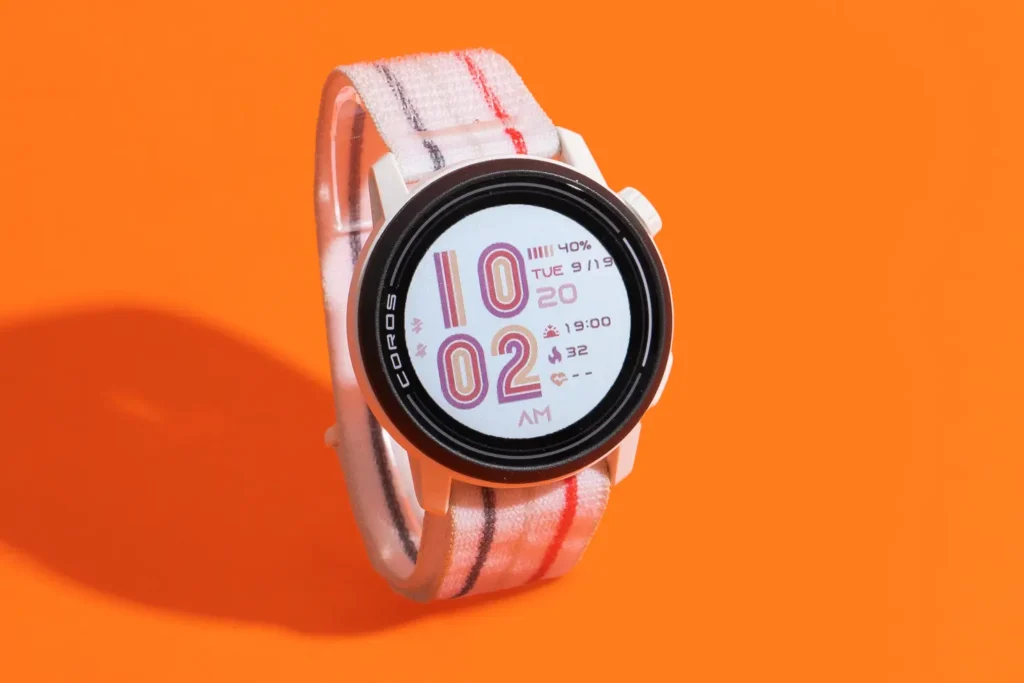
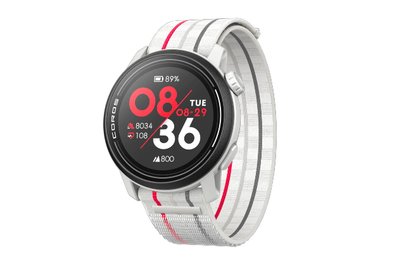
Coros Pace 3
The best GPS running watch
This watch excels at tracking runs. It has a better GPS and battery life than the competition, but its touchscreen display is not as sharp.
The Coros Pace 3 provides high-end running features at a decent price. It incorporates dual-frequency GPS, and it has one of the longest battery lives we’ve seen in a running watch.
It has an appealing color touchscreen. Despite lacking an AMOLED screen (which the Garmin Forerunner 165 has), the Pace 3 has an easy-to-read, multicolored display, and it can be customized to show everything from step count to heart rate.
It’s also touchscreen-enabled, a new feature to the Pace series of watches.
The touchscreen can be turned on or off in settings. And during runs, I found it easier to use the wheel button on the right side of the face to easily scroll through screens showing useful information such as pace, lap time, heart rate, and distance.
With one press of the wheel button, you can also access a history option that shows a log of recent workouts.
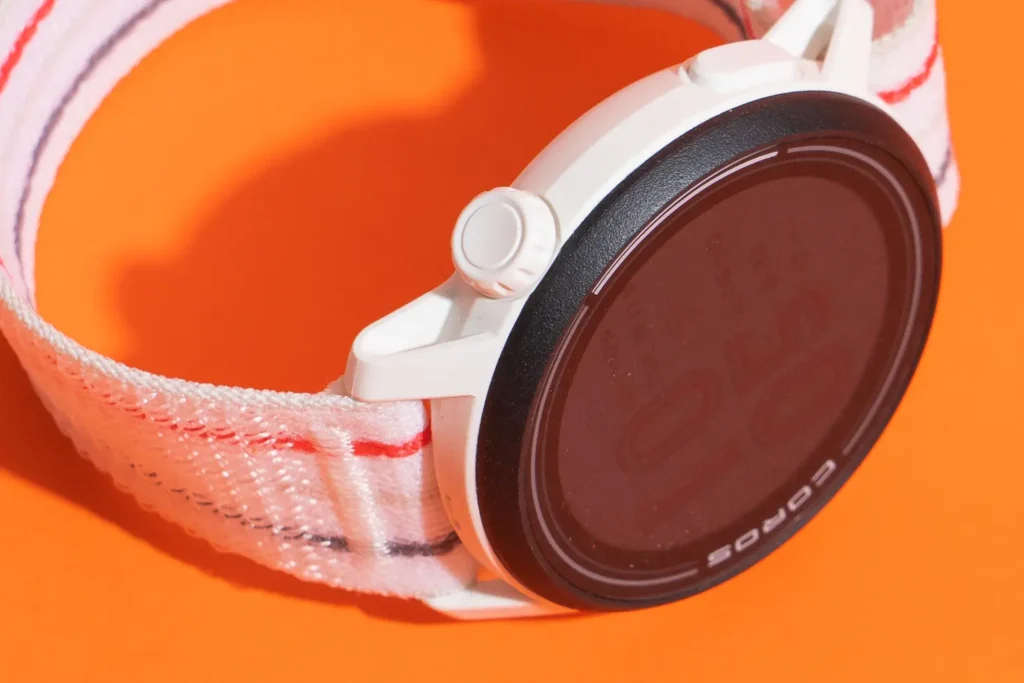
The Coros Pace 3 comes with a nylon band (pictured) or a silicone band. Although it’s washable, the white nylon band on our test watch became discolored over time.
It has an impressively long battery life. Upon release, in non-GPS mode, the Coros Pace 3 was supposed to last a whopping 24 days. In my testing, after I wore this watch for two days (with regular use, including one run with GPS turned on and one run with it off), the battery was at 92%, putting the Pace 3 close to its stated battery life.
Coros announced that, with a recent firmware update calculating a daily stress feature, the Pace 3 should last 17 days due to a change in update rates. However, you can turn these features off for the longer battery life of nearly 24 days. After almost a year of using it, I found no drop-off in battery-life strength.
Before you start a run, a meter shows you how many battery-life hours remain.
It’s more accurate than competitors. In our 1-mile running test (which I performed with all of our watches), the Pace 3 was off by just -0.03 miles (only the Apple Watch Ultra, off by -0.02 miles, performed better).
During regular runs on the 1.58-mile reservoir loop in Central Park, the Pace 3 was never off by more than 0.1 miles (if there is a weak signal, a satellite icon occasionally pops up).
During a heart-rate test, the Pace 3 registered +/-5 beats per minute of the reading on a Polar H10 heart-rate sensor 70% of the time.
It’s lightweight. I measured the Pace 3’s weight at 1.06 ounces.
The Pace 3 has a two-year warranty.
Flaws but not dealbreakers
The screen is not as vibrant as those of other watches. The Pace 3 doesn’t have an AMOLED screen, so in darker settings its color presentation isn’t always the brightest. It also doesn’t have an automatic shut-down button, which would be nice (the watch can be powered on by holding the bottom right button for a few seconds).
Some straps attract dirt easily. The white nylon Velcro strap that came with the watch I tested was comfortable to wear. But it quickly started to show some discoloration, and that only escalated over time due to accumulation of sweat and dirt. However, the fabric bands can be washed. The silicone strap on another Pace 3 I tested shows far less wear.
Runner-up: Garmin Forerunner 165
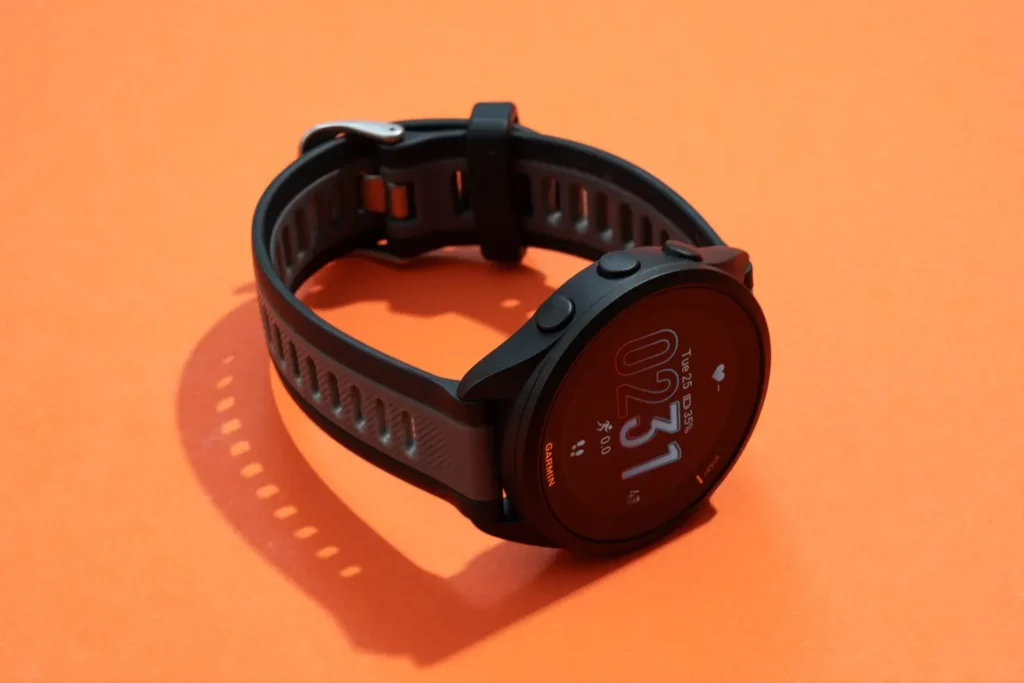
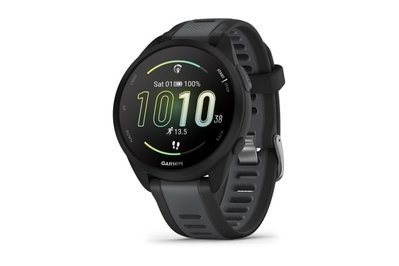
Garmin Forerunner 165
A GPS running watch with a smartwatch feel
This watch has an AMOLED touchscreen and advanced run-tracking features. But it has a shorter battery life than our top pick, and it often takes longer to acquire a signal.
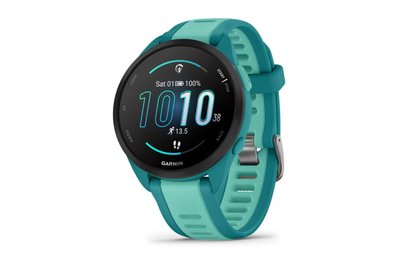
Garmin Forerunner 165 Music
The same watch, plus music
This is the same watch, but with music-streaming and storage capabilities.
The Garmin Forerunner 165 is a sleek, effective GPS running watch.
It has a shorter battery life than our top pick, the Coros Pace 3, and in our tests the Forerunner 165 often took longer to acquire a signal.
It also lacks the built-in music storage our top pick has (you can purchase the Forerunner 165 Music for $50 more), but it has a crisper touchscreen and nicer overall presentation.
It offers great value if you’re set on using a Garmin watch. If you want a Garmin, but you’re unsure which of the company’s plethora of devices is best for you, the Forerunner 165 provides a solid middle ground.
This model has an AMOLED screen and optional music storage, which were previously available only on Forerunner models costing around $200 more.
The Forerunner 165 sacrifices some battery life and advanced running metrics found on higher-end Garmin models, but it provides enough to satiate most runners.
According to one tester, this model is “classic Garmin,” with intuitive button placement, a bright display, and responsive touchscree

The Garmin Forerunner 165 has five side buttons, including three on the left side (these can be used for navigation) and a screen brightener. Two buttons on the right side start or stop workouts and help you go back through screens.
The GPS connection is solid. On our first couple of runs with the watch, I found that the Forerunner 165 took noticeably longer to connect to a signal than the Coros Pace 3 did. But it eventually balanced out and connected fairly quickly, even in race settings, surrounded by thousands of people and spotty cell service.
Its measurements are also reliably accurate: One tester ran two half-marathons (about 13.1 miles), which measured at 13.32 miles and 13.26 miles, respectively.
The watch is easily navigable and customizable. Due to the Forerunner 165’s responsive and clear touchscreen, it’s easy to change the layout, from adding one-touch access to workouts, such as treadmill work and stairs, to checking your heart rate.
The Forerunner 165 and Forerunner 165 Music are both covered by a one-year warranty.
Flaws but not dealbreakers
The battery life is not as strong as that of our top pick. The Forerunner 165’s listed battery life is 11 days, short of the Coros Pace 3’s listed duration of 17 days.
In our two-day battery test, the Forerunner 165 had 80% battery remaining, putting it on pace to come in under the 11-day estimate (and, for us, it did come in slightly under, lasting just about 10 days). Still, it should provide at least a week of continuous use, and it charges quickly.
If you want to control music through the watch, you’ll have to buy the Forerunner 165 Music. This model has 4 GB of storage, the same as the Coros Pace 3.
Budget pick: Garmin Forerunner 45

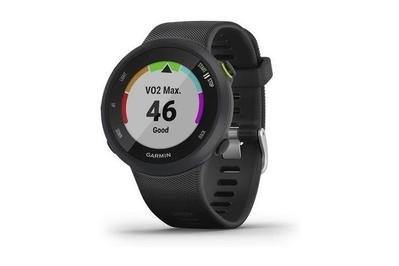
Garmin Forerunner 45
A solid running watch that covers the basics
This pared-down watch has fewer features than our other picks (and no touchscreen), but it still tracks runs better than most fitness trackers.
For a GPS running watch that handles the basics well but does little else, the Garmin Forerunner 45 is the one to get.
It’s a more stripped-down version than the Forerunner 100- and 200-level models, and it’s less customizable. But it’s good at tracking runs, and it’s easy to navigate.
It’s accurate but has a shorter battery life. In our tests, the watch’s heart-rate and distance tracking fell a shade below those of our other picks, but nothing was egregiously off. The listed battery life is seven days (and it’s reduced in GPS mode). And after two days of continuously using it, I found it had 70% remaining; ultimately, it lasted as long as advertised.
It still offers more than a typical fitness tracker. Although the watch doesn’t have features like training readiness scores, found on other Garmins models, you can track non-running workouts, such as cycling and yoga. It also has a heart-rate monitor, but I found it to be a bit erratic when I was engaged in intense activities.
Flaws but not dealbreakers
It’s glitchier than our other picks. Testers have experienced some hiccups with the Forerunner 45 that didn’t occur with other Garmin models, such as getting disconnected from phones and having to shut off the watch and turn it back on to reestablish a connection.
It’s missing extras. There’s no option for onboard music storage and playback, and due to the lack of a touchscreen, this watch can look a tad outdated.
The Forerunner 45 has a one-year warranty.
What about GPS data privacy concerns?
GPS running watches can gather a substantial amount of personal data, including your age, contact information, heart-rate readings, and location.
If you’re concerned about digital privacy, it’s crucial to understand how the companies that manufacture and support your devices handle your data. To avoid unexpected surprises, be sure to read a company’s privacy policies carefully.
Remember that if you share data with third-party platforms like Strava or MyFitnessPal, you’ll also need to familiarize yourself with their privacy policies.
While the data collected by your GPS running watch may seem harmless, it’s difficult to predict how it might be utilized in the future. For instance, location data has been used in unforeseen ways, such as when Strava data inadvertently revealed the locations of military bases in 2018.
Both Coros and Garmin require standard information to set up their devices, including gender, birth date, height, and weight, and they seek permission for Bluetooth access, location tracking, and camera use. Both companies state that they encrypt data both at rest and in transit.
Neither company shares data collected by their devices or apps with third parties for marketing purposes, nor do they use it internally for marketing or other purposes.
Coros and Garmin undergo third-party security audits; Garmin users who suspect a security issue can report it through designated channels.
As of now, neither Coros nor Garmin has experienced any known data breaches in the past two years.
Another good GPS running watch
If you prefer a Garmin with a better battery life: The Forerunner 265 is advertised as lasting up to 13 days (versus 11 days for the Forerunner 165).
When the Forerunner 265 was released, last year, we praised its beautiful AMOLED touchscreen and user-friendly interface. But now you can get the same display on our runner-up pick, the Forerunner 165, and save about $200.
The Forerunner 265 offers several features that the Forerunner 165 does not, including a convenient Run button on the side of the watch face. This allows you to start tracking a run instantly—no scrolling necessary.
Additionally, the Forerunner 265 includes a training-readiness feature, which the Forerunner 165 lacks. This feature provides helpful prompts regarding when and how intensely you should train, enhancing your overall training experience.
In terms of GPS signal acquisition and distance tracking, the Forerunner 265 performs comparably to the Forerunner 165, ensuring reliable performance for your running sessions.
What about the Apple Watch?
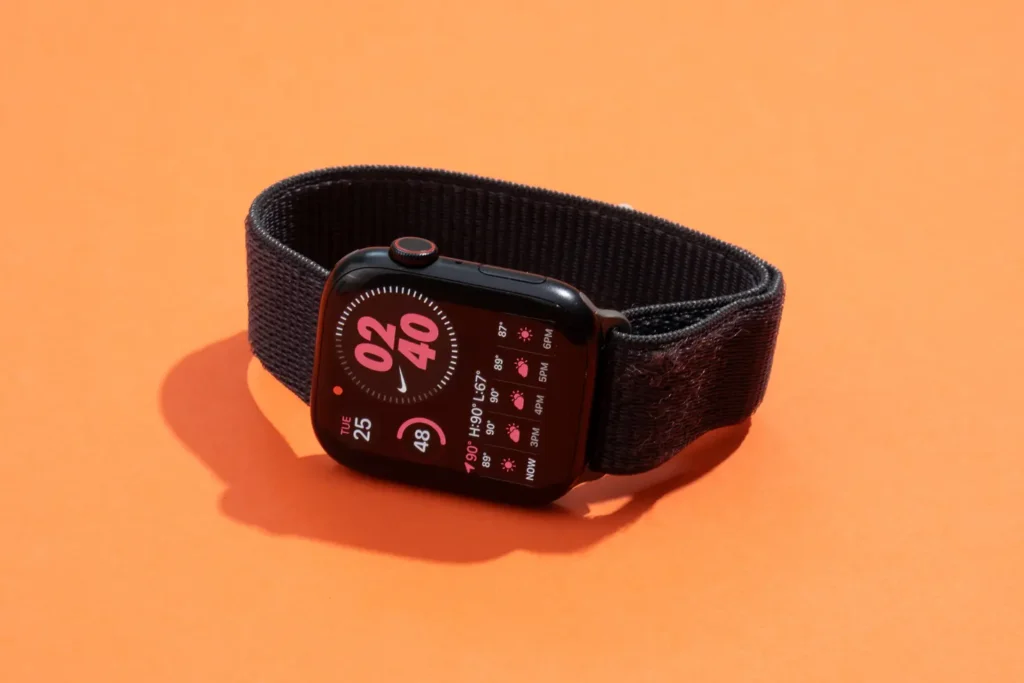
Overall, Apple Watches track runs quite effectively, but our recommended models outperform them due to superior battery life, seamless integration with both iOS and Android systems, and better pricing.
For this guide, I tested the Apple Watch Series 9 in the same manner as the other watches (we also recommend the Apple Watch SE in our guide to fitness trackers). It’s important to note that Apple can still sell the Watch Series 9 amid an ongoing patent dispute.
In our 1-mile distance-accuracy test, the Apple Watch Series 9 recorded a distance of 0.97 miles and demonstrated heart rate measurement accuracy comparable to our top picks. Although Apple Watches do not provide a meter or notification when a GPS signal is acquired, I found the Watch Series 9 to be quite proficient in tracking runs and routes.
The Watch Series 9 features a slightly larger case than the SE (1 millimeter larger) and is equipped with a faster chip. It also includes an electrocardiogram (ECG) app, more advanced cycling programs, and an always-on Retina display with a brighter touchscreen and higher resolution than the SE.
Both watches have relatively short battery life (around 18 hours), although the Series 9 performs better when operating in low-battery mode. The Series 9 typically costs about $150 to $200 more than the SE. Therefore, if you’re seeking an Apple Watch to begin tracking serious runs, the SE is a more cost-effective option that delivers similar performance to the Series 9, minus a few extra features.
What to look forward to
We’re currently testing the Suunto Race S ($350), which features an AMOLED display, 95 sport modes, and offline maps. This watch is equipped with a dual-frequency/multiband global navigation satellite system (GNSS) and is designed to be water-resistant up to 50 meters. Advertised at a lightweight 2.1 ounces, the Suunto Race S offers impressive battery life that varies depending on GPS usage. In optimal GPS mode, the watch can last up to 30 hours, while it can stretch to five days in a lower GPS setting with heart rate monitoring turned off. For extended use, the battery can last up to 13 days with both GPS and daily heart rate monitoring disabled.
The competition
The Amazfit GTS 4 Mini initially appeared to be an intriguing budget option, but it soon fell short of expectations. While the GTS 4 Mini accurately tracks distance runs and boasts an impressive 15-day battery life in non-GPS mode, it comes at a lower price point than the Garmin Forerunner 45, our top budget pick. However, the band feels flimsy, and the clasp can be difficult to secure. On multiple runs, I experienced issues where the display wouldn’t boot up when I turned my wrist, which is a key feature it’s supposed to support.
The Apple Watch Ultra features a longer battery life and a larger display compared to other Apple Watches. It includes an orange “action” button on the left side of the case, which allows you to create shortcuts to specific apps; this button is particularly useful for jumping right into a workout, especially when you’re wearing gloves. The watch utilizes dual-frequency GPS for enhanced signal strength, providing highly accurate tracking. However, it is heavier than other models. I opted not to test the latest Apple Watch Ultra 2 due to its substantial size and starting price of $800.
The Coros Apex 2 shares several similarities with the Pace 3, but it does have some notable differences. One key distinction is that the Apex 2 does not offer multiband GPS; for that feature, you’ll need to opt for the Apex 2 Pro, which usually costs an additional $100. Additionally, while the Apex 2 lacks an AMOLED display, it compensates with advanced features like the ability to download maps—ideal for hikers and trail runners navigating rocky terrains. The Apex 2 boasts impressive battery life, lasting up to 17 days in regular mode and 45 hours when utilizing GPS.
The Fitbit Versa 4 has a unique design, with a square face that isn’t too heavy. And it tracks steps and distance accurately—as we’ve come to expect from Fitbit. However, the battery life (six days) is short. The Fitbit Versa 4 is only about $30 less than the Coros Pace 3.
I was fascinated by the Garmin Forerunner 955 Solar’s solar-power capabilities. In GPS mode, this watch claims an impressive 49 hours of battery life with the aid of solar charging, and it reportedly lasts up to 20 days in non-GPS mode. However, I noticed that the watch’s touchscreen glitched several times during my runs, which made it challenging to read the display effectively.
The Garmin Forerunner 255S (formerly our runner-up pick) has multiband GPS, dependable measurements, simple interfaces, and extensive options for athletes who train both on and off the road. But the Garmin Forerunner 165 offers a similar performance, and it has a better display and an AMOLED touchscreen—for about $100 less.
The Garmin Venu 3 has an AMOLED touchscreen, up to 14 days of claimed battery life, and features for wheelchair users, including push tracking. Its main upgrades over other Garmin watches deal with sleep, including a sleep coach and nap detection. When it comes to running, this model was on a par with the Forerunner 165 and 200-series watches. Unless you’re really focused on sleep tracking, the Forerunner 165, which regularly costs almost $200 less, is just as good for running.
The Polar Pacer Pro is targeted at maximizing your training, and it’s equipped with a feature to gauge whether you’re doing productive workouts or overreaching. The scale was somewhat effective, but on occasion I thought it didn’t accurately judge how I felt during a strenuous run. This watch also has breathing tips, which I found to be minimally helpful. The face has an always-on display, which drains the battery (the Pacer Pro lasts seven days on a full charge or 35 hours in GPS mode). Some may prefer that the display is always ready to view during a run. There’s no touchscreen, however, and the charger felt flimsy and not very durable.
The Polar Vantage V2 is Polar’s premium sport watch, and it typically costs around $170 more than the Polar Pacer Pro. On one of my first runs with this watch, the pace time froze at 99:59 after 1 mile. And this happened a few times afterward.
If you’re a runner aiming to compete in ultramarathons or extended long races, the Suunto 9 Baro offers impressive battery life, lasting well over 24 hours in GPS mode. However, it doesn’t particularly excel in tracking distances, heart-rate readings, or in-app features. Compared to newer models, it feels a bit dated. Additionally, the band has a flimsy and thin feel, reminiscent of a hardened Fruit Roll-Up. On a positive note, the watch face is compatible with most 24-mm replacement bands that are widely available online.
Sources
- Bryan Heiderscheit, PhD, physical therapist and professor of orthopedics and rehabilitation at the University of Wisconsin-Madison and director of the UW Health Sports Medicine Runners Clinic, phone interview, June 14, 2022
- John Scott-Railton, senior researcher, The Citizen Lab at the University of Toronto, email interview
- Robert Gregory, PhD, associate professor, department of health and movement sciences, Southern Connecticut State University, Zoom interview, August 3, 2023
- David Martin, All-American and Team USA elite amateur triathlete, co-director of athlete safety and performance at the Korey Stringer Institute at the University of Connecticut, Zoom interview, October 3, 2023


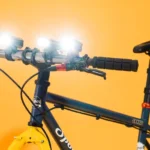 0
0
 0
0
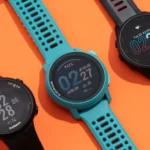 0
0
 0
0